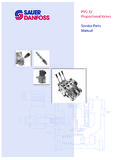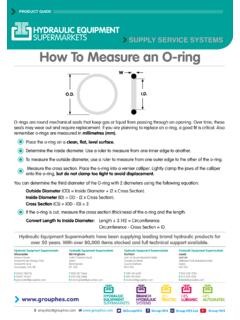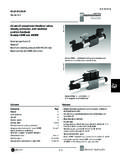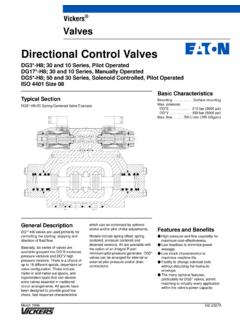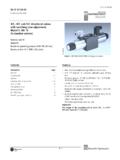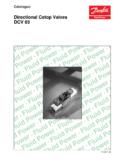Transcription of A guide to selecting a manual hydraulic directional ...
1 A guide to selecting a manual hydraulic directional control Author: Steve Skinner valve Characteristics and configurations of manual directional control valves used in hydraulic systems - selecting the right valve for the job. directional control valves are probably the most common of all hydraulic components and are used to control the starting, stopping and reversal of flow in a system. They are often associated with the control of a hydraulic actuator, such as a cylinder or motor, to select either forward, reverse or stop' but can also be used anywhere in a system where flow needs to be switched between alternative paths. In some cases, the directional valve offers minimum therefore control both the inlet and exhaust flow from a restriction to the flow as it passes through the valve double acting cylinder or motor.
2 Thus acting simply as a flow switch'. In other situations the valve can also act as a regulating valve to restrict the The second factor in the valve selection process is the flow rate and thereby control the speed of operation of an number of spool positions required. Normally this will be actuator for example. In many applications the transition a choice between a two-position or three-position valve from one situation to another, eg. the starting, stopping and will depend upon the requirements of the system. or reversal of an actuator and load, will require careful Considering a four-port valve controlling a cylinder as consideration. shown in figure 2, a two-position valve will be able to direct the fluid flow to either fully extend or fully retract the piston The selection of the correct directional valve for depending upon the spool position.
3 With the three-position a particular application is therefore not always a valve however it is also possible to centre the valve and thus straightforward process and careful consideration has stop the piston at any point along its stroke. to be given to the type and configuration of valve used. Although solenoid operated valves in industrial systems REVERSE FORWARD. and sectional valves in mobile systems are the most commonly used directional control components, there are many situations where a simple manually operated directional valve is also of use. This may be either as the TWO - POSITION. main directional valve in simpler systems or for a back- up/emergency operation in more complex ones. REVERSE STOP FORWARD. This paper will therefore review the choices and characteristics of common manual directional valves available in order to help the applications engineer or system designer in selecting the correct valve for the job.
4 THREE - POSITION. Fig. 2. BACKGROUND. The first consideration when selecting a directional valve The configuration of two-position valves can be either for use in a hydraulic system is to determine how many spring-offset or detented. A spring-offset valve, as its ports or flow paths are required. Generally speaking, name suggests, will be biased by means of a spring to one valves are available with either two, three or four ports as position or another such that when the valve operating shown in figure 1. lever or plunger is released the valve will automatically return to its offset position. In some applications this could A. be used to return an actuator to its normal or parked'. position when the operator releases the lever or to prevent TWO PORT a machine operation unless the valve is actuated.
5 From a A B. safety point of view however, consideration must be given P to the consequences of a spring failure in the valve. A B A detented valve has no spring return or offset feature THREE PORT. P and having moved the valve lever and spool it will simply stay in position when released. Normally there will be some form of detent or friction grip mechanism included FOUR PORT to ensure that the valve cannot then move inadvertently P T. (due to vibration for example). Fig. 1. A three position valve can also be detented to remain in It could be argued however that a two port valve is more any one of its three positions or it can be spring-centre accurately described as an on/off valve since it does not which means that the valve will spring back to its centre control the flow direction but simply switches it on or position when the lever is released.
6 Typical graphical off. The three-port valve has an inlet (P) port which symbols for the two types of valve are shown in figure 3. can be switched between two possible outlets (A or B). depending upon the state of actuation of the valve. The four-port valve adds a return to tank (T) port and can 2. amount of waste heat generated in the system but it also A B. means of course that the pump flow is not available to operate other functions while the valve is centred. SPRING CENTRED. To enable a float condition of the A and B ports but P T retain use of the pump flow for other functions, the A B configuration shown in figure 4c could be used which has the P' port blocked but maintains the A' and B' ports open to tank. DETENTED.
7 Alternatively, if it is required to unload the pump but P T prevent movement of the actuator the tandem' centre Fig. 3 condition can be used as shown in figure 4d. As before however, depending upon the type of valve used, leakage The flow configuration of the valve in the centre position may still take place into or out of the A' and B' ports is something that will often require careful consideration. when the valve is centred. Just about any configuration is possible from all ports blocked to all ports connected together but figure 4 As mentioned previously, many different configurations illustrates some of the more common arrangements. are possible in the valve centre position but the four illustrated in figure 4 are the most common.
8 Which A B A B configuration is most suitable will depend therefore on the whether the pump flow needs to be unloaded or not and the characteristics and requirements of the actuator A and its associated load. a) CLOSED b) OPEN CENTRE CENTRE. P T P T. Certain types of manual directional valve enable the A B A B. flow paths to be opened and closed progressively thus providing a degree of flow control in combination with the basic directional valve function. This can provide the operator with a means of controlling the speed of c) FLOAT d) TANDEM an actuator and also control of its rate of stopping and CENTRE CENTRE. P T P T starting (acceleration and deceleration). Fig. 4. Finally the pressure and flow ratings of the valve need An all ports blocked configuration (a) will block off the to be determined.
9 This is normally a straightforward pump flow at the P' port (thus enabling the pump flow process once the system design parameters have been to be used in other parts of the system) and at the same calculated with respect to flow and pressure. When time block flow into or out of an actuator thus locking controlling differential area cylinders however, it must it in position. It should be remembered however that, be remembered that the area and volume on either side depending upon the type of valve used, it may still be of the piston will be different which means that the flow possible to have leakage from any port to any other port rates through the two flow paths of the directional valve when in this position which could allow the actuator to will also be different.
10 For example, if the cylinder has a creep. Also of course with a hydraulic motor, there will full bore to annulus area ratio of 2 to 1, the exhaust flow inevitably be leakage internally in the motor across the from the annulus side will be half the inlet flow to the full ports and possibly into its external drain connection so bore side when extending. More significantly however, even a leak-proof valve will not positively lock a motor the exhaust flow from the full bore side when retracting in position. In some applications however, a leak- will be twice the inlet flow to the annulus side. For this proof valve will be a distinct advantage, for example in reason the flow rating of the directional valve chosen clamping applications or where pressure on a cylinder is may have to be greater than the pump flow alone.
